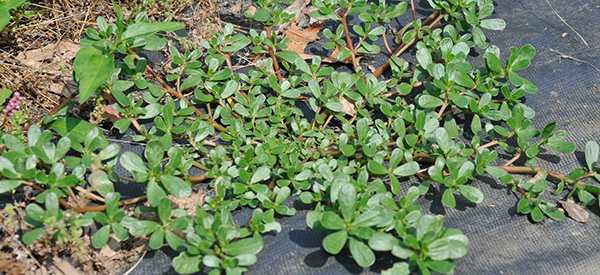
If You See This Weed Growing In Your Yard, Don’t Pick It – Here’s Why
Herbal medicine hasn’t changed at all. The same plants provide the same medicinal benefits as before, even though most people are unaware of them and leery of their veracity.
In a post-disaster world, herbal medicine may be the only option left to us. When Big Pharma can no longer make and distribute their products to the pharmacies and physicians who dispense them, people will still need medicine. The solution for most will be to turn to the little bit they know or can learn about herbal medicines. Learning about them now merely gives us a head start.
Meet Purslane
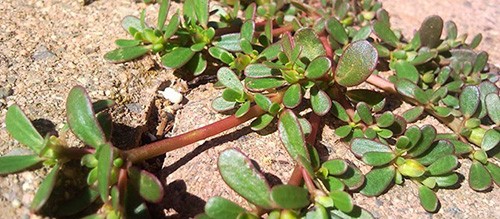 Chances are fairly high that you already have purslane growing somewhere in your yard, this prolific weed grows around the world, and can be found from coast to coast in the Continental United States. About the only place, you can’t find it in the USA is in Alaska, where the climate is just too cold for it.
Chances are fairly high that you already have purslane growing somewhere in your yard, this prolific weed grows around the world, and can be found from coast to coast in the Continental United States. About the only place, you can’t find it in the USA is in Alaska, where the climate is just too cold for it.
Purslane is a leafy plant, which produces yellow flowers. The stems of the plant are reddish on the top and light green on the bottom. Purslane leaves are spatula-shaped and slightly puffy, especially during the summer, which is the best time to harvest them unless you live in the south, where you can harvest them all year long.
You must be careful not to confuse purslane with the spurge weed, which looks similar but is poisonous. There are a couple of ways of telling the difference between the two. First, purslane can grow to be 12” to 15” tall, while the spurge lays flat on the ground. But this is not definitive as it depends on the growing conditions. The best test is to break the stem and squeeze out a bit of the sap. Spurge will have a milky sap (you shouldn’t eat any plants with a milky sap) and purslane will have a translucent, almost clear one.
As long as you have real purslane, any part of the plant which grows above the ground is safe to eat. It can be eaten raw or cooked in a variety of ways, just as if you were using any other leafy vegetable. The flavor is something like spinach and can be considered a substitute for spinach or watercress in salads and recipes. It can even be pickled to preserve it.
What’s So Special About Purslane?
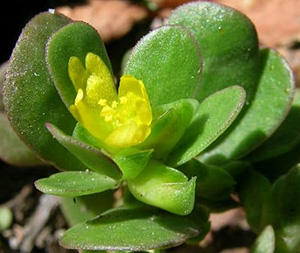 Although we consider purslane a weed, it is one of the most nutritious plants you can find, packed with important micronutrients, while being low on calories. It contains beta-carotene, vitamins A, C, and E, as well as some of the B vitamins, magnesium, calcium, potassium, folate, lithium, and protein.
Although we consider purslane a weed, it is one of the most nutritious plants you can find, packed with important micronutrients, while being low on calories. It contains beta-carotene, vitamins A, C, and E, as well as some of the B vitamins, magnesium, calcium, potassium, folate, lithium, and protein.
But the most important thing this vegetable contains, is Omega-3 fatty acids, 8.3 mg for every gram of weight. Nutritionists have long touted the importance of eating fish or taking fish oil, as a source of Omega-3. Purslane provides an even better source of this nutrient for those who can’t or don’t want to eat fish.
It is also an excellent source of melatonin, which helps regulate sleep. Melatonin is an antioxidant, which acts as a hormone. It is naturally found in the body, as a product of the pineal gland. Those who have trouble sleeping often have a low level of melatonin in their bodies, which is normally treated by taking melatonin in tablet form. However, this plant offers levels of melatonin that are as much as 1,000 times higher than that available in any other plant.
What Can Purslane Do?
Purslane is a natural anti-inflammatory, antibacterial and antifungal, much like garlic. This makes it an excellent all-purpose herbal treatment for a variety of different ailments. The list of common ailments that can be treated with purslane, as part of an overall treatment strategy, is impressive:
Skin Problems
- Burns
- Dermatitis (skin irritations)
- Insect stings
- Pruritus (severe itching of the skin) – this is a symptom of various ailments
- Skin sores
- Abscesses (an area of pus, under the skin, caused by an infection)
- Eczema (white patches of the skin that are rough and inflamed)
Any of these skin problems are best treated by making a poultice and applying it directly to the affected area. To make a poultice, grind up enough purslane (leaves and stems) in a mortar and pestle to cover the irritated area. You don’t need a thick coating, an eighth of an inch will do. The key thing is to have enough to cover the entire area. Apply the ground-up purslane to the affected area and cover with a cloth (a gauze pad works well); then tie in place. You can use an elastic bandage or elastic gauze for this.
Leave the poultice in place for at least 30 minutes. Repeat the treatment two to three times per day. The same poultice can be used up to six times, as long as it is kept moist. However, if it dries out enough that the sap from the leaves is no longer visible, it should be thrown away and replaced.
Earache
Earaches are normally a form of infection. Due to their location, they are best treated with a tincture, as shown below. Put three to four drops of the tincture in the ear canal and hold it in place by stuffing a small piece of cotton ball into the ear canal. Leave in place for at least 10 minutes, before removing the cotton.
Repeat this treatment three to four times per day, until at least two days after the earache is gone. Please note that the pain will stop before the infection is fully eliminated. That’s why it is necessary to continue treatment after it seems to be healed.
Internal Infections
- Colitis (inflammation of the large intestine’s lining)
- Dysentery (a bacterial infection of the intestines)
- Enteritis (the inflammation of the small intestine) – which can be caused by viral or bacterial infection, poor blood flow, inflammatory conditions, or problems with alcohol or drug abuse
- Fever
- Painful urination – usually caused by an infection
- Shingles (an inflammation of the nerve ganglia in adults, caused by the same virus that causes chickenpox in children)
- Stomach aches – a common bacterial infection
The body’s immune system fights against these internal infections. Purslane can help by augmenting the body’s natural antibodies. To use purslane for internal infections, add about 1/8 cup of purslane leaves (whole or chopped) to salads or vegetables in each meal (three times per day). You can also eat the leaves directly, but it is more flavorful as part of other foods.
Please note that since purslane is a natural herbal remedy, you basically can’t overdose on it, unless you try to make your diet wholly of purslane. Any excess that you eat, over and above what your body needs, will be eliminated as waste.
Other Ailments
- Arthritis
- Diabetes
- Headaches
- Ulcers
As with infections, treatment of these ailments is best accomplished by adding purslane to the diet, making it part of your salads and vegetable dishes. These are serious conditions, which purslane cannot cure on its own. However, it will help in your body’s fight against them.
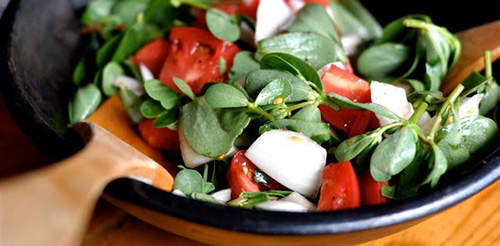
Please note that there are other conditions for which people have claimed that purslane has made a difference, but these are not confirmed. The ones listed above are conditions where there is enough evidence to show that purslane has made a significant difference in dealing with the condition.
This does not mean, however, that purslane is a miracle cure, which will take care of these conditions with one dose. Most of these conditions need time to heal, but purslane promotes that healing. It also promotes general health, when consumed as a regular part of your diet, helping to prevent these conditions from occurring.
How To Use It
As with many herbal medicines, there are a variety of different ways of using purslane. You can buy dried and crushed purslane, to be taken as a dietary supplement. However, we’re operating under the assumption that you need a purslane for survival purposes, where that won’t be available.
For internal infections and other conditions, the purslane is best eaten, either raw or cooked. However, as is typical for vegetables, some percentage of the nutrients come out of the plant while it is being cooked, especially if it is boiled. Using it raw, such as in a salad, ensures that all the nutrients are received.
When using purslane or other herbal medicines for treating skin disorders, burns, or insect bites, it is best to make it into a poultice and apply it directly to the affected area, binding it with a cloth. Crush the purslane with a mortar and pestle, before applying, so that the inner part of the leaf and the sap can make contact with the infection. The nutrients will then be absorbed directly through the skin.
Tincture Of Purslane
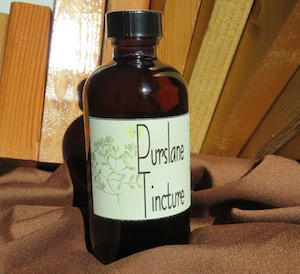 In a few cases, such as earache, it is best to make a tincture out of the herb, creating a concentrated form of the herb (much like essential oil) which can be applied with an eyedropper. This is accomplished by soaking the leaves (preferably crushed leaves) in alcohol, allowing the alcohol to draw out the nutrients. You need high-proof alcohol for this (at least 80 proof) or as an alternate, you can use apple cider vinegar.
In a few cases, such as earache, it is best to make a tincture out of the herb, creating a concentrated form of the herb (much like essential oil) which can be applied with an eyedropper. This is accomplished by soaking the leaves (preferably crushed leaves) in alcohol, allowing the alcohol to draw out the nutrients. You need high-proof alcohol for this (at least 80 proof) or as an alternate, you can use apple cider vinegar.
To make a tincture, crush the leaves and place them in a pint jar, filling the jar 1/3 to ½ of the way full; don’t pack the leaves down. Then fill the jar with alcohol and seal it shut. Store the jar in a cool dry place and shake daily for three weeks or more. When the tincture is done, filter out the leaves and store the final product in a colored dropper bottle.
Tinctures made with alcohol will keep indefinitely, but tinctures made with apple cider vinegar need to be refrigerated. Even then, they will only keep for about six months.
You may also like:
 Burdock: The Annoying Weed That Can Save Your Life
Burdock: The Annoying Weed That Can Save Your Life
Erratic Blood Sugar? Never Eat This Veggie (Video)
How to Make Dandelion Bread (With Pictures)
How To Make An Anti Inflammatory Herbal Jar (Pickled Purslane)

Here in the southwest purslane grows the same as spurge and the never grow tall always close to the ground,we have different recepies for it and it never used like spinach or watercrest since they have different tastes I could go on but maybe later.
Hi Roy,
Sounds very interesting. What recipes do you use it for?
very interesting. I always considered them as weeds, I will try it.
Hi Wayne,
I am glad to hear this. Please let us know if you liked it 🙂
Interesting
Hi Charles,
If you try it please let us know if you liked it 🙂
I got a salad at subway and it had purslane in it
Thanks I’ll try it
Hi Earl,
Looking forward to your feedback 🙂
I LIKE THIS
Hi Russell,
We are glad to hear this. Please let us know if you try it 😉
This is interesting, thank you. I noticed that you said “cooked this vegetable has less nutrients than raw.” I learned in my medical classes that while this is probably true, many vegetables provide less nutrients when eaten raw due to a lack of bioavailability. I know this seems backwards to what we’ve been taught, but a tremendous amount of studies support this.
Many studies suggest that steeping your vegetables at about 145-170 degrees for 10 minutes. This allows more bioavailability of nutrients without killing all of the enzymes. Both of which provide a tremendous benefit to our health. Also, many studies suggested that eating steeped vegetables with a small portion of raw vegetables and, when not toxic, eating the raw seed can give the greatest benefit of all.
Lastly, another way to eat vegetables to increase our health is fermented, like Kimchi. This is super easy to do at home, it increases the bio availability, it helps our gut receive somewhat pre-digested food, it helps to pre-digest the other foods we consumed during the meal, and it helps us maintain a proper weight by reducing storage of carbs/fats, as well as reduce cravings after a meal.
If I mis-stated any thing or if any new information contradicts this, I am sorry. It has been 15 years since I took those classes.
Hi Richard,
Thank you so much for your thoughtful feedback. I also love kimchi 🙂
Thanks loads for the information! and you had retained that after all this time! Wow!
Thank you very informative, be blessed
I’m not a medical doctor or have I went to school for it, but what I’ve researched over the years is we’ve been lied to about many things . Cooking most of your vegetables or herbs takes the nutritional benefits out. Follow the money and when the alternative medicines were made illegal to subscribe by medical Dr’s and you’ll see what I’m talking about. Read up on who started big pharma and supported all of the medical schools, and who told them what was and wasn’t allowed. I’m not trying to step on your toes or say your wrong I’m just trying to share the information I’ve come across. God bless
Thank you! I have it growing in my garden in New Jersey but it never grows tall. The sap is clear however and I really appreciate this knowledge.
Hi Rachael,
Thank you so much for your kind words. We really appreciate it. Please let us know if you try it 🙂
you said: “you shouldn’t eat any plants with a milky sap”
I have been planting yam/sweet potatoes (yes they are confused here in USA) for the leaves and tubers I eat .. When cutting the stalk/leaves, they have white milky sap that even stains. What is the reason for your statement above? Thank you
Hi Richie,
There’s a difference between eating plants which have been cultivated and are known to be safe to eat, and eating unknown plants, testing them to see what is safe to eat. While there are cultivated plants which have characteristics of those which are dangerous when found in nature, such as sap in the stems, the bulk of the plants found in nature, which have sap in the stems, are dangerous to eat. Therefore, in a survival situation, where you don’t know what is safe to eat, it is best to avoid those plants until they can be properly identified.
God bless!
Where do you get your alcohol to make your tinctures?
Hi Elizabeth,
Thank you so much for your comment.
Most spirts will work, but many herbalists favor a high-quality, clear, and low-flavor liquor like vodka or grain alcohol. Note that stronger alcohol types can be diluted with distilled water to reach a lower alcohol content by volume.
God bless!
I would also like to know what kind of alcohol is used? I will be trying that in my salad. Sounds yummy. Been wanting to do that for quite a while now. Thank you 🙏.
Still do not understand the alcohol in the tincture. It’s written 80 proof, I cannot seem to find vodka with 80 proof . Here we have alcohol at 40% alcohol. Is that okay?
80 proof is 40% alcohol
Wow, this is mind-blowing! We have this plant in our garden and I always uproot them as weed to give way to vegetables that I know to be food. Thank you for this information; I will be careful not to destroy them next time. This is good information.
Thank you so much for your comment.
Benefits of purslane are unexpected indeed!
God bless!
I also have this in my garden. Will try to make a tincture but will also use it in a salad. Sounds delicious 😋. If it can help my body I am ready and willing to taste it. Thank you for your knowledge. ❤️
In sri lanka we do eat purslane when available, addred to Dhal curry like adding spinach.i am lucky that one day reading your article on purslane, i ran down and to identify it to be sure, and boy oh boy how lucky i was it was purslane. Now seeing its benefits i have decided to go into p cultivation and i educate as many people as possible. Recently i decided to have a little seminar on purslane so that my church members could learn its benefits too. Have you got anything else edible stuff as the coming times ahow that we will needn this information. I have started taking photos of our types of weed too in order to make a little booklet that will be useful for identification.
Hi Srahi,
Thank you so much for your comment and for sharing your experience as well!
I am happy that the article helped you!
God bless!
You can buy Nicole’s book The Lost Book of Herbal Remedies which includes edible wild plants. There are other books on edible wild plants too, look online as I cannot remember the names.
Can you purchase or order seeds? Occasionally I find some but not very much. My Aunt who lived to be 95 had me eating this when I was young and would love to have a supply in my garden. Thank you for the information on white or clear sap.
Hi Carol,
Thank you so much for your comment.
You can purchase purslane seeds using the link below:
https://www.ebay.com/itm/300-Purslane-Seeds-Organic-Non-GMO-Portulaca-oleracea/184291273804?hash=item2ae89dac4c:g:gcMAAOSw99JddlJg
God bless!
how can you tell the difference in the 2 besides 1 grows tall? I am reading that both grow flat in CA and I am in CA. So I need to know how to tell them apart
I have read that it was Mahatma Gandhi’s favorite vegetable.
I will be watching for these. Thank you, again, for sharing great information.
Thanks for the heads up, I notice it is in the portulaca family .. I grow some portulaca for flowers.. I just purchased seeds from your eBay link ..
As children on the farm we would pull this, growing wild, to feed the pigs. They loved it! My mother did not want it growing in her vegetable patch. No wonder the pigs squealed with delight when we gave it to them. Thank you for letting me know how good it is for humans as well.
I am still waiting to receive my book ordered some time ago. Please look into this for me
Dear Nicole I love all the the priceless information you are stating in your books and on line. However, I purchased The lost book of Remedies-” fantastic book” but I got the bonuses as well and can”t find the receipt anywhere on my computer therefore I cannot access the download can you help please?
we will not go through pay pal to order to easy for pepole to to accssees your info. i would like to solar packet for 39.00 but they wont take our card. i ordered your lost herb book and had no problem
So to source this plant, would I be looking for “Portulaca oleracea” which is what I know as a trailing plant that blooms?
Years ago a son of mine worked at a small fruit stand next to a peach orchard. A group of Hispanic men stopped by and asked him if they could pick the weed that was in the orchard. He said fine and they picked a whole box of it. He asked them what they used it for and they said they ate it. He mentioned it to me and I told him what the plant was as I eat it occasionally. I can’t persuade my family to eat it unless I hide it in a smoothie.
[…] If You See This Weed Growing In Your Yard, Don’t Pick It – Here’s Why […]